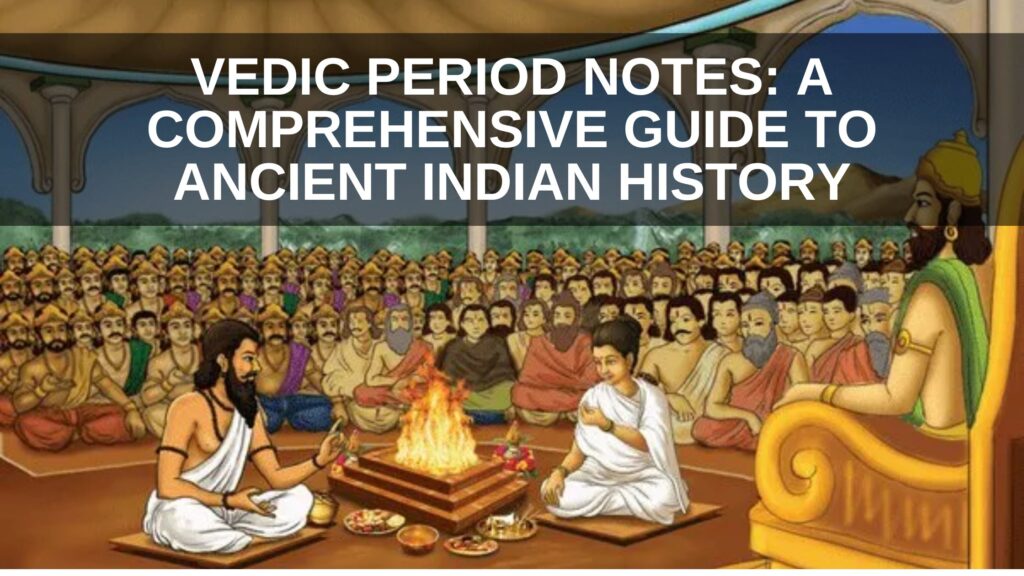The Vedic Period (1500 BCE – 500 BCE) marks a transformative era in Indian history. This period witnessed the arrival of the Aryans, the composition of the Vedas, and the establishment of early social, religious, and political institutions. The roots of modern Indian culture can be traced back to this significant epoch.
The Aryan Migration Theory
The origin of the Aryans has been a subject of debate. Early scholars proposed the Aryan Invasion Theory, suggesting that the Aryans invaded India around 1500 BCE. However, this theory has been largely dismissed in favor of the Aryan Migration Theory, which posits that Aryans migrated gradually into the Indian subcontinent from the steppes.
Linguistic and Archaeological Evidence
- Sanskrit, the language of the Aryans, belongs to the Indo-European language family, linking it to several European languages.
- The introduction of the horse, not prominently found in the Indus Valley Civilization, is believed to be linked to the Aryans.
- References to Indo-Aryan cultural elements have been found in Mitanni inscriptions in northern Syria, reinforcing the migration theory.
Read about.. Harappan Civilization
Phases of the Vedic Period
Early Vedic Period (1500 BCE – 1000 BCE)
The early Vedic people settled in the Sapta Sindhu region (Punjab plains), with major rivers such as the Indus (Sindhu), Beas (Vipash), and Ravi (Parushini) playing crucial roles.
- The Rigveda, the oldest Vedic text, primarily mentions the Indus river system, while the Ganga is mentioned only once.
- Society was primarily pastoral, with cattle rearing as the dominant occupation.
- The early Vedic economy revolved around cattle wealth, and war was often referred to as Gavisthi (search for cows).
- The society was tribal and kinship-based, with kings known as Rajan, assisted by purohitas (priests) and senanis (military commanders).
- Women enjoyed relatively higher status, with access to education and public assemblies.
Later Vedic Period (1000 BCE – 600 BCE)
This phase saw the expansion of the Vedic people into the Gangetic plains (Aryavarta) and the adoption of iron tools, facilitating large-scale agriculture.
- Painted Grey Ware (PGW) culture emerged, indicating advanced pottery techniques.
- The caste system began to take shape, with references to four Varnas (Brahmins, Kshatriyas, Vaishyas, Shudras) in the Purusha Sukta of Rigveda.
- Political structures evolved, leading to the rise of Janapadas (tribal republics).
- The role of kings became more prominent, with elaborate yajnas (sacrificial rituals) like Rajasuya and Ashwamedha reinforcing their authority.

Vedic Literature
The knowledge of the Vedic Age comes primarily from its rich textual tradition. Vedic literature is classified into two categories:
Shruti Literature (Heard) – Considered Eternal and Divine
- Vedas: The primary sacred texts, consisting of four Samhitas:
- Rigveda (Hymns in praise of gods like Indra, Agni, and Varuna)
- Yajurveda (Sacrificial rituals)
- Samaveda (Musical chants, precursor to Indian classical music)
- Atharvaveda (Magic spells and healing practices)
- Brahmanas: Prose texts explaining rituals.
- Aranyakas: Philosophical interpretations of rituals.
- Upanishads: Philosophical discussions on the ultimate reality (Vedanta philosophy).
Smriti Literature (Remembered) – Subject to Change Over Time
- Puranas (Mythological and historical narratives)
- Itihasas (Epics like Ramayana and Mahabharata)
- Vedangas (Auxiliary sciences to understand the Vedas)
Religion and Society in the Vedic Period
Vedic society was polytheistic, with a focus on nature worship. Important deities included:
- Indra (God of Thunder and Rain, most revered in Rigveda)
- Agni (Fire God, mediator between heaven and earth)
- Varuna (Guardian of cosmic order)
- Soma (Deity associated with ritual drink)
Sacrificial rituals (yajnas) were central to religious life. Over time, spirituality evolved towards philosophical introspection, as seen in the Upanishads.
Political and Social Structure
The society was organized into tribes (Janas), ruled by Rajan (king), with the support of purohitas (priests), senanis (army commanders), and gramins (village heads).
- Clan-based assemblies like Sabha and Samiti played a role in decision-making.
- Cows were the main measure of wealth, and conflicts often arose over cattle and land.
- The varna system began to solidify in the later Vedic period, laying the foundation for caste divisions.
- Women had an important role in early Vedic society, but their status declined in the later period.
Economy and Daily Life
The economy transitioned from a pastoral-based to an agrarian-based system with the use of iron tools.
- Crops grown: Barley, wheat, rice (rare), and pulses.
- Crafts: Pottery (Painted Grey Ware), metalwork (copper, bronze, iron), weaving, and chariot making.
- Trade was conducted through barter, and taxation was voluntary (Bali).
Major Conflicts and Tribal Wars
The Battle of Ten Kings, mentioned in Rigveda, was a significant tribal conflict fought on the banks of the Ravi River. The Bharata clan, led by King Sudasa, emerged victorious against a coalition of ten tribes.
FAQs Related to the Vedic Period
Q1. What is the Vedic Age?
The Vedic Age (1500 BCE – 500 BCE) marks the period when the Vedas were composed and Indo-Aryans settled in India, shaping early Hindu society.
Q2. Who were the Aryans?
Aryans were Indo-European tribes who migrated into India around 1500 BCE, introducing Sanskrit and Vedic traditions.
Q3. Why is Vedic literature important?
Vedic literature provides insights into early Indian society, religion, and philosophy, forming the foundation of Hinduism.


